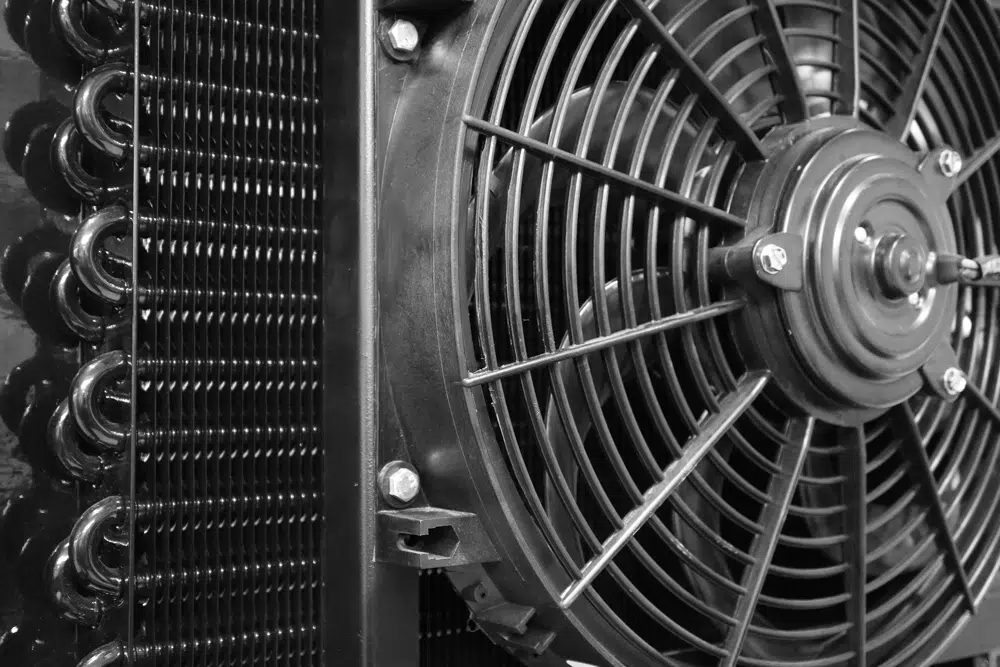By Wenguang Zhao, Sahan Wasala, and Tim Persoons
Introduction
Forced air cooling remains essential for dissipating the heat generated by high-power-density devices in modern electronics [1]. Axial fans are widely used in information technology, telecommunications, automotive, and aerospace applications for air cooling. The aerodynamic performance (P–Q) curve of fans is essential for designing and optimising air-cooling systems. However, fan performance modelling can be challenging and is dependent on numerous factors that must be accurately accounted for. The lumped fan (LF) model is a well-established practise for modelling electronic enclosures with forced convection cooling by simplifying fan geometries as a plane. However, this makes it difficult to precisely predict swirl velocity profile and fan performance, leading to some margin of error in thermal-flow designs [2]. Although higher fidelity, three-dimensional computational fluid dynamics (CFD) methods, such as the steady/unsteady Reynolds-averaged Navier-Stokes approach (U/RANS) and large eddy simulation (LES), have been proven more reliable in modelling fan performance, the high computing resource demand limits their use in rapid industrial design and optimisation cycles [3].
This study aims to develop and validate an analytical model for the fast and accurate prediction of the aerodynamic performance (P–Q) curve of axial cooling fans, accounting for actual fan geometry and the tip clearance effect. This prediction tool is anticipated to be highly appropriate for rapid design, analysis and optimisation of electronics cooling fans and enclosures, thereby facilitating future co-design of thermal-flow and noise.
Analytical Model
An analytical model for predicting the aerodynamic performance of fans was previously introduced by the authors in [4], [5]. This quasi-3D method was developed based on the lifting line theory, combined with blade element theory (BET) and the viscous vortex panel solver XFOIL [6]. The method is parametric and utilizes the actual blade geometry while accounting for tip loss. It assumes minimal radial flow, which allows the fan blades to be considered as a series of 2D radial elements. The shroud improves fan performance by suppressing tip vortices, and the method treats this suppression as an increase in sectional lift coefficients. The key equations of the analytical model are presented in this section and it was implemented in MATLAB.
Figure 1 illustrates the velocity triangles of a typical fan element. In practical applications, downstream stationary objects, such as streamlined stators/guide vanes or non-streamlined struts, are often present. This study models the downstream structure as an ideal stator with an imaginary shape that can fully recover the pressure loss due to the rotational velocity component, which is equal to ρvu2/2.
The thrust and torque for a radial element can be expressed as

where Cl, Cd are the lift coefficient and the drag coefficient, respectively. r, Ω, B and c denote the blade radius, rotational speed, number of blades and chord length, respectively. is the effective inflow angle with respect to the rotor plane, which can be determined as
where Ø1 and Ø2 are the inflow angle at inlet and outlet, respectively.
a′ is the tangential induction velocity factor (u = Ωr(1 – a’)), which can be expressed as
where is the total relative velocity at the blade leading edge
The root and tip loss for a finite-span blade were accounted for by assuming an elliptical lift distribution along the span. Based on the lifting line theory, the induced angle of attack can be determined as
where α denotes the effective angle of attack (α = ß – Ø)
The downwash resulting from the tip vortices exerts a diminishing effect on the lift coefficient slope of an airfoil with an infinite span. Therefore, the finite airfoil lift coefficient Cl is expressed as
where Cl,∞ is the lift coefficient of a 2D airfoil with infinite span, obtained by XFOIL [6]. m is the slope of Cl,∞ with respect to α. Lift and drag coefficients are calculated by polynomial interpolation from a pre-computed table, based on α. To ensure numerical stability, all aerodynamic data were computed using XFOIL in the range of -20º to +20º, extended to ±180º with the Viterna method [7]. XFOIL uses the en method to predict laminar-to-turbulent flow transition [6]. The parameter Ncrit =5 was utilised to represent relatively high turbulence inflows.
By substituting Eq. (5) with Eq. (6), and solving iteratively, the effective angle of attack α for each blade element can be determined. Then the forces and velocities can be obtained by solving Eq. (1) – (4).
The static to total pressure can be determined as
where, T is the total thrust of the rotor and A is the fan area.
This method considers the impact of tip clearance on fan performance using the effective aspect ratio AReff, which incorporates the correction factor MAR with the geometric aspect ratio AR. A shroud can mitigate tip vortices and improve blade performance, but its effectiveness decreases with increasing tip clearance. To account for this, the tip clearance effect is modelled as an increase in MAR, and a linear correlation equation has been developed to select the appropriate value of MAR, which can be expressed as
Equation (8) is an empirical equation based on several CFD studies and experiments, which is recently developed in [8]. TR is the tip clearance ratio, which is defined as TR = t/Rt, and has a valid range from 0% to 10%. t and Rt denote the tip-gap width and the blade tip radius.
The theoretical fan performance based on Euler’s work equation can be used for comparison with the developed method [9]. Assuming flow alignment with the geometrical camber line and ideal stator recovery of downstream pressure loss, the ideal static to total pressure can be expressed as [8]
where vu = u-vcotØ2•Ø2. can be approximated as the angle between the tangent of the camber line at the trailing edge and rotor plane.
Experimental Setup
To experimentally validate the proposed fan model, a wind tunnel was developed based on ANSI/AMCA 210-16 [9], as shown in Fig. 2. A modification was made to the setup by using a standardised orifice plate, in accordance with ISO 5167-2:2003 [10], to measure airflow rates. This method provides high accuracy and is easier to implement than the Pitot tube method used in the original AMCA standard. A honeycomb flow straightener is used to rectify non-axial airflow, and a throttling device at the end of the tunnel enables control of the fan backpressure. Due to the presence of system resistance inside the tunnel, the static pressure around the fan outlet cannot reach the free delivery condition (zero backpressure). In this case, an auxiliary fan could be added as an exhaust system. The total volumetric flow rate, Q, and the static-to-total pressure rise across the test fan, P, can be obtained following the ANSI/AMCA standardized procedures [10].

Case Study
An 80 mm diameter cooling fan with 5 blades and a blade tip clearance ratio of 2.5% was selected to validate the aerodynamic model. The fan, which operates at 9000 RPM, is used in a commercial multiple hard disk drive enclosure and has been previously studied in [4], [5]. The blade tip radius and hub radius are 37.35 mm and 18.7 mm, respectively, while the tip Mach number is approximately 0.1 and the averaged chord-based tip Reynolds number is around 60,000.
The blade was divided into sections and twist and chord distributions were extracted from a CAD file (see Figure 3). Airfoil profile coordinates were non-dimensionalized to calculate aerodynamic coefficients. In cases where CAD files are unavailable, 3D scanning can be used to extract blade information. If none of these options is available, airfoil databases such as [12] may be used to find a similar airfoil based on maximum camber and thickness measurements. For the test case, the mid-span airfoil profile had a maximum thickness of 6.7% at 23.6% chord and a maximum camber of 2.2% at 49.0% chord. This information aided in identifying similar airfoils in [12], specifically AG26 and AG17, which were selected to assess the model’s sensitivity to airfoil coordinates.
To determine the optimal aspect ratio correction factor , Equation (8) was employed with a tip clearance ratio of , resulting in a value of 4.6. The fan performance curve (P–Q) was calculated using the analytical model outlined in Section II.
Figure 4 shows the predicted P–Q curves with the optimal correction factor (MAR = 4.6) using the three similar airfoil profiles, compared to the reference data provided by the manufacturer and experimental data. Reasonable agreement is observed between the predicted results using the real fan airfoil profile and the experimental data, except for some discrepancies near and after the stalling dip, as shown in Fig. 4. The normalized root-mean-square error (NRMSE) is 5.0% in the nominal working region, while it increases to 13.0% in the stall region. The flow becomes unstable and separates in the stall region, increasing the radial flow component, causing the axial fan to behave like a mixed-flow fan [13] and invalidating the zero-radial flow assumption. Although this XFOIL [6] based model can partially predict near-stall and post-stall fan performance, it is less accurate in the stall region due to the absence of radial flow consideration. Moreover, Figure 4 demonstrates that using similar airfoil profiles (AG26 and AG17) in this method can provide comparable predictions except for the stalling dip region, which appropriately relaxes the minimum requirement of this model for airfoil profile data.
To further investigate the influence of airfoil characteristics on the prediction of the fan PQ curve, various NACA 4-digit airfoil profiles were employed. NACA 4-digit is a system for airfoil designations developed by NACA. It uses a four-digit number to describe an airfoil’s shape and characteristics, including maximum camber, camber position, and thickness-to-chord ratio. To represent the original fan profile, a NACA 2507 was used as a baseline case, having 2% maximum camber, positioned 50% from the leading edge, and a 7% thickness-to-chord ratio. Additionally, NACA 2503 and NACA 2515 airfoils were chosen to investigate the impact of airfoil thickness, while NACA 0507 and NACA 6507 airfoils were employed to examine the effect of airfoil camber. Figure 5 illustrates the results, showing that airfoil thickness primarily influences the onset of the stall region, while exerting minimal impact on the low-pressure region. On the other hand, airfoil camber plays a more significant role in the prediction of the PQ-curve, as it can modify the zero-lift angle of attack and affect the overall performance of the fan.
Figure 6 depicts the impact of effective aspect ratio correction factor on predicted P–Q curves for different MAR values (1 ≤ MAR ≤ ∞) in comparison to the reference, experimental, and ideal curves. Generally, an increasing MAR value leads to higher predicted fan performance. Specifically, MAR = 1 indicates a fan with finite span and large tip clearance, while MAR → ∞ approximates an ideal fan curve for a fan with infinite span and zero tip clearance. The proposed aspect ratio correction factor, MAR, demonstrates promising analytical capabilities in accounting for finite span and tip clearance effects in predicting fan curves.

The proposed aerodynamic model can be seamlessly integrated with an aeroacoustic model to predict far-field noise levels. More details on this aeroacoustic model can be found in [4] [5].



The combined model takes approximately 10 minutes on an Intel Xeon E5-2630v3 CPU utilizing 8 cores (1.3 core-hours), which is more than three orders of magnitude faster than the high-fidelity method (9,600 core-hours) in [3].
Conclusion
In this study, an analytical model was presented to analyse the aerodynamic performance of electronic cooling fans in a computationally efficient and accurate manner. The model accounts for the actual fan geometry and the impact of tip clearance. This model was validated against experimental tests conducted on a standardized test facility, yielding a prediction error within 5% in the fan’s nominal working conditions. Overall, the proposed analytical model can reasonably predict fan performance with an ultra-low computational cost. This model could be beneficial in accelerating and optimizing the thermal-flow design of fan-cooled electronics systems, while also offering valuable insight into future noise control.
References
[1] S. V. Garimella, T. Persoons, J. A. Weibel, and V. Gektin, “Electronics thermal management in information and communications technologies: challenges and future directions,” IEEE Transactions on Components, Packaging and Manufacturing Technology, vol. 7, no. 8, pp. 1191–1205, Aug. 2017.
[2] G. V. Shankaran and M. B. Dogruoz, “Validation of an advanced fan model with multiple reference frame approach,” in 2010 12th IEEE Intersociety Conference on Thermal and Thermomechanical Phenomena in Electronic Systems. Las Vegas, NV, USA: IEEE, Jun. 2010, pp. 1–9.
[3] S. Wasala, Y. Xue, T. Wiegandt, L. Stevens, and T. Persoons, “Aeroacoustic noise prediction from a contra-rotating cooling fan used in data center cooling systems,” in AIAA AVIATION 2021 FORUM. AIAA Paper 2021-2313, 2021. [Online]. Available: https://arc.aiaa.org/doi/10.2514/6.2021-2313
[4] W. Zhao, S. Wasala, and T. Persoons, “Reduced-order aeroacoustic modeling of electronics cooling fans,” in 28th International Congress on Sound and Vibration, Singapore, 2022. [Online]. Available: https://iiav.org/content/archives_icsv_last/2022_icsv28/content/papers/papers/full_paper_91_20220418214546788.pdf
[5] W. Zhao, S. Wasala and T. Persoons, “Towards quieter air-cooling systems: Rotor self-noise prediction for axial cooling fans,” in 28th International Workshop on Thermal Investigations of ICs and Systems (THERMINIC). IEEE, Sep 2022, pp. 1–4. [Online]. Available: https://ieeexplore.ieee.org/document/9950669/
[6] M. Drela, “XFOIL: An analysis and design system for low Reynolds number airfoils,” in Low reynolds number aerodynamics, T. J. Mueller, Ed. Berlin, Heidelberg: Springer Berlin Heidelberg, 1989, pp. 1–12.
[7] R. D. Viterna, L. A., Corrigan, “Fixed pitch rotor performance of large horizontal axis wind turbines,” in NASA Lewis Research Center: Energy Production and Conversion Workshop. NASA Lewis Research Center Cleveland, OH, United States, 1982. [Online]. Available: https://ntrs.nasa.gov/citations/19830010962
[8] Zhao, S. Wasala, T. Persoons, On the fast prediction of the aerodynamic performance of electronics cooling fans considering the effect of tip clearance, IEEE Trans Compon Packag Manuf Technol (in review, Apr 2023).
[9] W. T. W. Cory, Fans & ventilation: a practical guide. Amsterdam; Boston: Elsevier in association with Roles & Assoc, 2005.
[10] AMCA – The International Authority on Air System Components, “ANSI/AMCA Standard 210-16/ASHRAE Standard 51-16 – Laboratory methods of testing fans for certified aerodynamic performance rating,” 2016. [Online]. Available: www.amca.orgwww.amca.org/store.
[11] International Organization for Standardization, “ISO 5167-2:2003 Measurement of fluid flow by means of pressure differential devices inserted in circular cross-section conduits running full — Part 2: Orifice plates,” 2003.
[12] “Airfoil tools,” [Online]. Available: http://airfoiltools.com/, Mar. 2023. [12] F. P. Bleier, Fan handbook: selection, application, and design. New York: McGraw-Hill, 1998.
[13] P. Bleier, Fan handbook: selection, application, and design. New York: McGraw-Hill, 1998.
Authors
Wenguang Zhao is a Ph.D. candidate in Mechanical Engineering at Trinity College Dublin, under the supervision of Dr. Persoons. He is a research student in the NSF Cooling Technologies Research Center at Purdue University. He received his B.E. degree in Thermal Energy and Power Engineering from Southeast University in China in 2017, followed by a M.E. degree in Power Engineering and Engineering Thermophysics from the same institution in 2020. His research interests are primarily focused on the aerodynamic and aeroacoustic modelling, optimisation techniques, and noise control strategies for electronics cooling.
Sahan Wasala is a Visiting Research Fellow in the Department of Mechanical, Manufacturing & Biomedical Engineering at Trinity College Dublin. He was a SFI Research Fellow at CONNECT centre and a SFI RD&I Research Fellow at Seagate Technology LLC, USA. He received his Doctorate in Engineering Science at the University of Auckland, New Zealand. His research interests are focused on aerodynamic & aeroacoustics noise modelling and acoustic noise reduction methods, particularly using acoustic metamaterials.
Tim Persoons is Associate Professor in the Department of Mechanical, Manufacturing & Biomedical Engineering at Trinity College Dublin, and a visiting Faculty in the NSF Cooling Technologies Research Center at Purdue University. He received his Doctorate in Engineering from KULeuven in 2006. Dr. Persoons’ research activities include multi-scale convective heat transfer and fluid dynamics for electronics thermal management and related thermo-fluid applications. He has authored over 150 journal and conference publications, serves in editorial roles for IEEE Trans Compon Packag Manuf Technol, Exp Therm Fluid Sci, ITherm, Therminic, Eurotherm, and was co-recipient of the 2013 Hartnett-Irvine Award and the 2020 Harvey Rosten Award.












